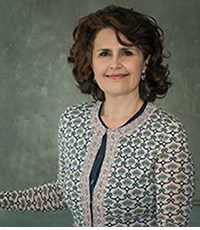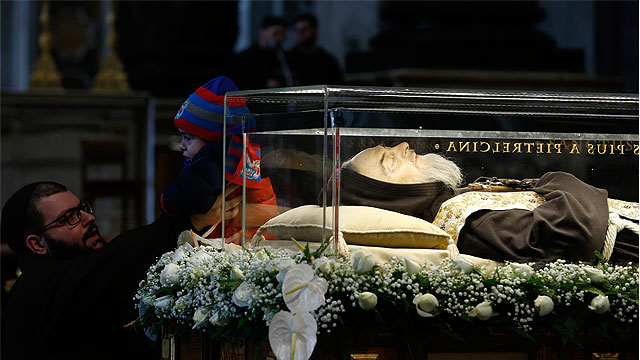

The spiritual bond between two Francises:
Pope Francis and Padre Pio
Salt + Light Media
Friday, May 25, 2018

CNS photo/L'Osservatore Romano via Reuters
In honour of the birthday of Padre Pio, we present you with this article written by Dr. Ines Angeli Murzaku on the occasion of the pilgrimage of his major relic to Boston in 2016.Cardinal Sean P. O’Malley of Boston announced on September 2 that the heart of St. Pio will be in the Boston area from September 21 through his feast day, September 23. Boston will be the only stop the relic will make during this trip. This is the first time any major relic of Padre Pio will be traveling internationally outside Italy. But there is another first: in February 2016, as part of the Extraordinary Jubilee of Mercy celebrations and upon special request by Pope Francis, the remains of St. Padre Pio were moved from San Giovanni Rotondo in Puglia, Southern Italy, to Rome for a week-long exposition. For the first time in one hundred years Padre Pio left the convent of San Giovanni Rotondo. Padre Pio is one of the patron saints for Francis’ Extraordinary Jubilee Year of Mercy together with St. Mother Teresa, who was canonized on September 4. What bonds the two Francises (Padre Pio’s name before ordination was Francesco Forgione)?
Periphery
Both Padre Pio and Pope Francis have a “peripheral” bond. Francis comes from the periphery: he was born and raised in Argentina, which is both a geographical and existential periphery; Francis is the first Latin American pope and the first non-European pope in modern times; and Francis was born and raised on the periphery of political and ecclesial power. Similarly, Padre Pio was born and raised in the little town of Pietrelcina in Southern Italy, which is a geographical and existential periphery of Italy; Padre Pio is also a “peripheral saint” who suffered and was marginalized, misunderstood and slandered, persecuted and imprisoned, and banned from celebrating Mass in public. Padre Pio suffered trials and punishments by the official Church when he was alive. In 1922, Fr. Agostino Gemelli, O.F.M., examined the stigmata of Padre Pio and claimed that they were a fraud. The Holy Office issued four decrees against Padre Pio in 1923, 1924, and two decrees in 1926 respectively. It took a Polish pope, John Paul II, to rehabilitate Padre Pio more than three decades after his death. He was beatified on May 2, 1999, and canonized on June 16, 2002, by Pope John Paul II. In a sense he was “peripheral” to the “central” Church, who misunderstood him. However, faithful and popular devotion decreed him a saint well before the official Church’s recognition and made the official Church follow suit. The mystic Padre Pio probably had anticipated his rehabilitation when he said: “I will make more noise when I am dead than when I was alive.” For Pope Francis who is facing resentment by many Catholics, the connection with Padre Pio resonates well.Prayer and Mercy in Action
According to Padre Pio’s biographer, Fr. Luciano Lotti, Cardinal Bergoglio had great esteem and a devotion to Padre Pio when he was in Buenos Aires. On the occasion of the Great Jubilee Year 2000, on special request from Bergoglio, a few minor relics of Padre Pio arrived in Buenos Aires. Moreover, in 2002, after Padre Pio’s canonization, Cardinal Bergoglio explored the possibility of establishing Padre Pio Prayer Groups (PPPG) in Argentina. Since 1947, at Padre Pio’s invitation, Prayer Groups were spontaneously springing up and taking on a more stable form with their focus on prayer or, more specifically, collective prayer. Eventually, PPPG were established in Argentina, and now there are approximately 70 such groups in the country. It is hard to forget the moment Pope Francis stepped out onto the balcony at St. Peter’s Basilica after his election. The first thing he asked of people was prayers before offering his papal blessing. Francis sees prayer as a vehicle for keeping faith alive and keeping the relationship with God current and open. He does not cease to encourage unceasing prayer. He authored the five finger prayer guide, when he was archbishop in Argentina. The apostolic effectiveness of Padre Pio, the profound root of his spiritual fruitfulness, can be found in his intimate and constant union with God. Padre Pio loved to repeat, "I am a poor Franciscan who prays," convinced that "prayer is the best weapon we have, a key that opens the heart of God" (from Pope John Paul II's homily at Padre Pio's canonization). But Padre Pio went a step further: he saw a close connection between prayer-contemplation and mercy in action. Padre Pio helped build the Home for the Relief of Suffering in San Giovanni Rotondo, one of the best hospitals in Southern Italy, which provides free medical services to the poor. The hospital is a place of prayer, contemplation and medical research, as desired by Padre Pio.The Smell of the Sheep
Padre Pio was a sought-after confessor as he “practiced, at times in exhaustion, the apostolate of listening.” Fr. Luciano Lotti describes St. Pio as a confessor as “roughly benevolent.” But Padre Pio was a genuine father to the people, a shepherd who deeply cared for his sheep. Even when he treated them harshly, he did so as a father: this explains why people flocked to him from all over the world. He spent seventeen hours a day listening to confessions and reconciling people, changing their hearts and lives. Similarly, Francis personally heard confessions in the Vatican at the beginning of Lent as well as went himself to confession, emphasizing the importance of this sacrament. The gift of God’s mercy is highlighted and experienced in a special way in the sacrament of reconciliation. So Francis and Padre Pio want to touch the wounds of the people and help to alleviate their sufferings, wearing the smell of the sheep. Another similarity between Francis and Padre Pio is the focus on the Eucharist. Padre Pio celebrated Mass every morning beginning at 4:30 AM. The Eucharist was the center of Padre Pio’s day: the celebration sometimes continued for three hours. People stayed in line for hours to participate. The same can be said for Pope Francis and his daily Mass in the chapel of the Casa Santa Marta. For Francis, Mass is a time "not just to pray, but to receive Communion -- this bread that is the body of Christ that saves us, forgives us, reunites us to the father. It's beautiful to do this." In sum, the mysterious, spiritual bond between Pope Francis and St. Padre Pio is that they are both shepherds living with the smell of the sheep, in touch with and touched by the wounds of the people. Ines Angeli Murzaku (http://academic.shu.edu/orien
Ines Angeli Murzaku (http://academic.shu.edu/orienRelated Articles:
<<














